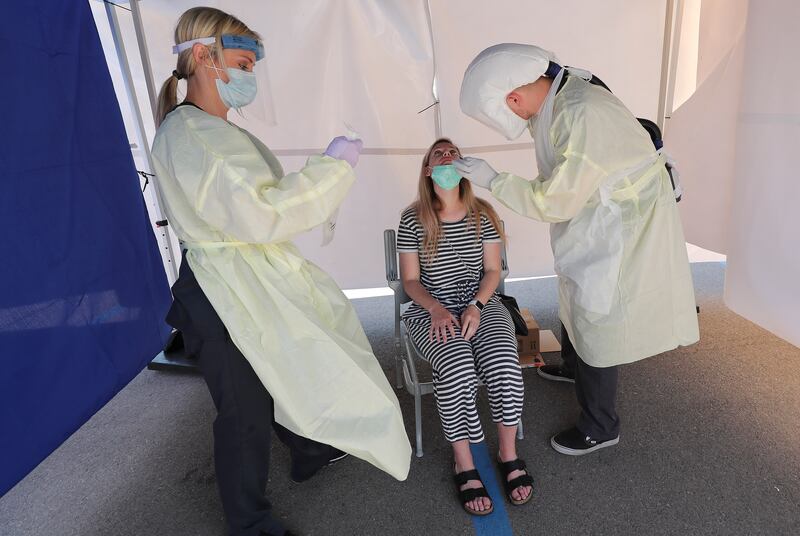SALT LAKE CITY — As Utah officials decide when to move areas of the state to a low-risk level, the number of new cases won’t matter so much as the current strain on hospitals, the transmission rate and the state’s testing and contact-tracing capabilities.
That’s according to members of Utah’s Public Health and Economic Emergency Commission, which was created during April’s special session of the Utah Legislature to allow lawmakers to help decide how quickly the state can begin rolling back restrictions. The commission then gives its recommendations to Gov. Gary Herbert, who decides whether or not to implement them.
“It’s the data. We’re not being driven by emotional decisions, we make decisions based on data. And if the numbers are there, then that’s absolutely what will happen,” Maj. Jefferson Burton, chairman of the commission and acting director of the Utah Department of Health, told the Deseret News and KSL editorial boards Tuesday.
He said an announcement from Herbert could come this week as the current order placing Utah under a moderate or orange risk level, which went into effect May 1, expires Friday night.
A spokeswoman for Herbert’s office confirmed he will hold a news conference on Thursday, and county risk levels could potentially be addressed then.
“We have a breakout by county of how they’re doing on those measurable data points that can determine whether they can go to yellow or not,” Jefferson said.
Hospital capacity remains adequate, as just 45% of beds in the state are being used — only 5% of them by COVID-19 patients, said Senate Majority Whip Dan Hemmert, R-Orem, who is also on the commission.
“The trigger point is that it’s below 60% ... in case there is a surge,” Hemmert said. No projections indicate the state’s hospital use will surpass 90% in the next seven to 14 days based on trends of new hospitalizations, he said.
Counties in southern Utah — including Washington, Kane and Iron — last week requested a move to the yellow or low-risk risk level, which would open the door for more recreational travel, a complete reopening of businesses, and gatherings of up to 50 people. The request, however, was put on hold as the area saw a nearly 50% growth in new cases, from 113 to nearly 170.
When officials say they are focusing on transmission rates, they’re actually talking about transmissions as they affect hospitalizations, as hospitalization rates need to remain flat, Hemmert said.
Officials have most of the data they need to decide whether to lower counties’ risk levels, Burton said, but some areas, including Piute County, are now short on their testing numbers, as testing and contact tracing remain the most complicated piece of the puzzle.
“In a perfect world, we would want everybody tested tomorrow. We don’t have that, so we’re working as fast as we can with the resources we have,” Burton said.
Meanwhile, just 40,000 people have signed up for Utah’s contact tracing app, Healthy Together, since it launched April 22, but more state employees are coming online to perform traditional contact tracing.
The state is also continuing to ramp up its contact tracing and testing efforts among communities hit disproportionately hard, including the Latino and Hispanic community which now accounts for 40% of confirmed cases.
Members of the National Guard are translating materials into Spanish and will visit Hispanic communities to perform tests and communicate “stay home, stay safe” measures to residents and businesses as the state transitions to the next risk phase, Hemmert said.
“It’s fair to judge that as we do open, and as counties go from an orange to a yellow, if that were to happen in the next week or two, you would probably see an increase in cases because we’re increasing our testing as well,” Burton said.
But more people have now recovered from the novel coronavirus in the state than those who still have it, he noted. Rising numbers “won’t necessarily be a bad thing,” he said.
If Utah does see a second wave, those same three “trigger points” of hospitalization rates, transmission rates and capacity to test will play into decisions to tighten restrictions.
New deaths, cases
Five more people have died with COVID-19 in Utah, bringing the state’s death toll to 73, officials confirmed Tuesday.
The latest fatalities include four Salt Lake County residents — two men between ages 60 and 84, and two women older than 80. The women and one of the men were residents in long-term care facilities, according to the Utah Department of Health.
The fifth death was a Utah County woman older than 85, also a resident in a long-term care facility.
Fewer tests were performed, at 2,900, bringing the state’s total to 153,485. Confirmed cases rose on Tuesday by 70 — a 1.1% growth rate since Monday — bringing the total to 6,432.
In Utah, 99 people are currently hospitalized for COVID-19, seven more since Monday. About 540 have required hospitalization at some point during the pandemic.
The latest breakdown of Utah cases, hospitalizations and deaths by health district:
- Salt Lake County, 3,414; 309 hospitalized; 49 deaths
- Utah County, 1,365; 80 hospitalized; 11 deaths
- Summit County, 388; 33 hospitalized; 0 deaths
- Davis County, 340; 28 hospitalized; 2 deaths
- Weber-Morgan, 207; 27 hospitalized; 3 deaths
- Wasatch County, 184; 8 hospitalized; 1 death
- Southwest Utah, 167; 13 hospitalized; 3 deaths
- San Juan County, 152; 16 hospitalized; 3 deaths
- Tooele County, 78; 6 hospitalized; 0 deaths
- Bear River, 80; 12 hospitalized; 1 death
- Central Utah, 28; 2 hospitalized; 0 deaths
- Southeast Utah, 13; 0 hospitalized; 0 deaths
- TriCounty (Uinta Basin), 16; 1 hospitalized; 0 deaths


